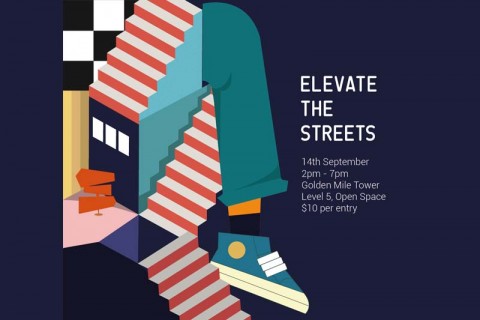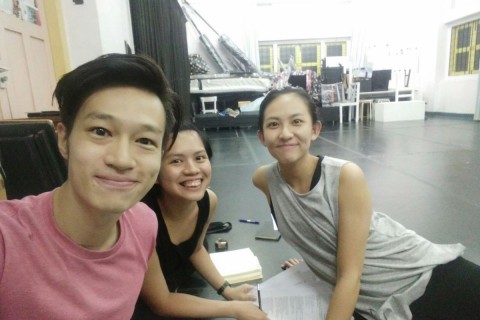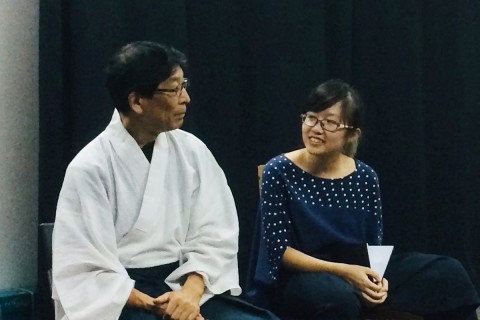Elevate the Streets marks the public launch of a pilot initiative to engage identified cases of youths-at-risk through well-designed dance workshops. Since March 2019, a team of seasoned youth breakdancers has been collaborating with Bethesda Care Services and Trybe Ltd to lead this voluntary programme. The inaugural Elevate the Streets dance jam aims to spread awareness on how hip-hop can make a positive impact, and also hopes to reach out to more dance-volunteers. We speak to the lead organiser, Michael Ng, and the team’s graffiti artist, Syafiq Noor, to find out more!

1. What do people do during a dance jam? Does everyone just get on the dance floor?
Dance jams are where street dancers meet up as a community to participate in organised dance activities. The most straightforward type of event would be the “battle” format of dance competition, where individuals or teams are paired to face off against each other. After taking turns to dance centrestage, a panel of judges will decide who wins the bout. These judges tend to be well-respected in the community by virtue of experience, skill or competitive achievements.
That being said, there is so much more to a dance jam beyond the main organised event. Regardless of how competitive you are, or how much you have prepared for the competition, the jam marks an opportunity for like-minded dance enthusiasts to commune, catch up and have fun doing what they love. With a steady stream of upbeat music mixed by the DJ, participants would organically form dance circles, or what we call ‘cyphers’, and take turns to get down and let loose. And when you’re tired from all that grooving, nothing’s stopping you from getting refreshments and having a good chat with friends you might not otherwise bump into.
2. Is there a structure or any unspoken dance rule to make the jam more fun or challenging?
I think what makes street dance styles, particularly b-boying, so fun and challenging is how free it can be. For starters, the music is never of your own choosing, so there’s that base level of unpredictability. In addition, looking different from others isn’t just acceptable - it is celebrated. In a well-organised jam, just these factors alone can contribute to an electrifying and dynamic atmosphere, where dancers get comfortable with expressing themselves in response to the music and each other’s movements. The music’s got to be good though!
On top of that, there are also a few means of spicing up the competitive event by adding a few creative rules to the format. I can cite ‘Conquer-it’, a dance jam where teams of 2 face off, and the winning pair gets to pick a member of the losing team to join them, allowing the line-up to stack all the way up to the finals! Our event also has an interesting format - check our facebook event page to find out more ;)
3. Can everyone join in the live graffiti during the event on 14 Sep?
Yes. There will be a half-finished piece available for members of the public to help outline.
4. How can we encourage positive, constructive forms of graffiti? I’ve met youths who have unfortunately chosen to vent their frustrations in a destructive manner, damaging public properties. Do you have any advice for youths to help them channel their frustrations in a more constructive way via graffiti?
Perhaps informing them about the legal spaces to practice is a good place to start. It is also important to remind them that graffiti is not a destructive activity - it is an artistic avenue for one to express themselves creatively and freely. If you’d like to paint, please do so in the legal, sanctioned areas that is Somerset Skatepark or the walls at the National Youth Council building in Somerset. Alternatively, you could also approach the artists at Blackbook Studio @ Sultan Gate if you’d like to paint on their private wall. They are always more than happy to allow you to practice there, and it is also a good place to meet other graffiti artists. Another avenue for practice is also the walls surrounding Aliwal Arts Centre, but you’d have to seek permission from any member of street art collective RSCLS as they are responsible for those walls.
In Singapore, there are strict laws and regulations surrounding vandalism and the damage of public property. Also, any acts of irresponsible behaviour may have negative repercussions to the graffiti scene itself, as a lot of us are working hand-in-hand with governmental agencies such as the National Arts Council. Many of us have worked hard to reach this level where we can have a mutual understanding with official bodies so as to push our art form onto a bigger stage. Best believe a lot of us are trying our best to secure more spaces for street artists to express themselves. If you are itching to paint and channel your inner artistic energy, please do so responsibly!

5. I had parents of students who disapproved of their children attending Kpop/hip-hop dance activities after school because they think the children are ‘not being serious and playing a fool’. Sometimes, parents also stick a ‘bad-boy’ label to the genre. Any advice to share to dispel the stereotypes?
It’s hard to avoid this label of deviance that is attached to the hip-hop subculture. Gangsterism and hooliganism are issues that have been running parallel with hip-hop’s history both in New York and right here in Singapore. It’s basically not the most sanctioned thing. At the same time however, it is that element of rebellion associated with the culture that makes it attractive to youths. I can’t deny that I was initially drawn to learning this dance from how ‘cool’ and ‘badass’ the b-boys looked. If it were too regulated and sanitised, the magic of it would be lost.
Rather than attempt to dispel these stereotypes (which are not unfounded), I thought to introduce the possibility that subcultural involvement is not necessarily a bad thing. In fact, this initiative potentially transforms all the years of ‘not being serious and playing a fool’ into powerful tools to reach out and make a difference in society. Perhaps, by being able to appreciate that it’s all a matter of perspective, parents of children who wish to get involved in street dance or hip-hop will have less of a knee-jerk reaction when hearing of it. I hope more people recognise that subcultures, like any other community, can play a vital role in helping young people make sense of the world around them, and the best thing parents can do for their children is to support the choices they make, as best as they can.

6. What role does a dancer-volunteer play during the programme or at the event? Do they need to possess a certain skillset or mindset? What do they need to be mentally prepared about?
I think to be a dancer-volunteer, there really isn’t much of a skillset needed beyond the basic moves. In fact, some of the social workers from Trybe were learning the moves together with us, and still were contributing their energy positively to the programme! All it takes is a heart to help, an open mind, a reasonable amount of patience, and just a few hours of your time a week for a given period, at your convenience.
Of course, this is not to say that the process of volunteering is easy. The whole journey of getting to know the youths, winning their trust and forging bonds with them was very much a learning journey for our team, and we were heartened that both Bethesda Care Services and Trybe Ltd gave us so much patience and leeway to find our own way to connect with the students. There’s no one way to do it, and there’s always room to grow.
Allow me to try and illustrate this: you get a handful of youths-at-risk to teach, but their circumstances would be wildly different. One of them can be loud and chatty with a temperament, and another can be facing self-esteem issues and refuse to open up in the first lesson. How do we engage a whole class full of such wildly differing personalities? In our case, we hope to solve this through strength of numbers. Ideally, we get as many facilitators as youths. And each dancer-volunteer will attach themselves to just one or two of these youths and tend to their needs, talk to them, make an effort to understand them better.
So each facilitator’s process would definitely be different, and there’s no one formulaic way to gain rapport with the kids. But it’s all very worth it when you see them having fun, learning how to overcome obstacles and challenges that are part of the dance, and even taking away some important life lessons through these activities. And it’s even more gratifying when you realise that its your presence, as well as your experiences as a dancer, that really made an impact. Even if it is just a few hours, even if it is just one person throughout the whole programme. In many ways it adds so much more meaning and value to the dance you’d otherwise consider as a side hobby.
------
Elevate the Streets Jam 2019
Date: 14 Sep 2019
Time: 2:00pm - 7:00pm
Venue: Golden Mile Tower Carpark Space, Level 5
Go to event page →

 Three by Three @ 126 – Interview with Ellison Tan
Three by Three @ 126 – Interview with Ellison Tan
 Dear Directors – What it is like to be the heads of the Family
Dear Directors – What it is like to be the heads of the Family
 Entering Southernmost - Interview with Sim from Emergency Stairs
Entering Southernmost - Interview with Sim from Emergency Stairs